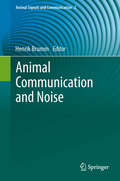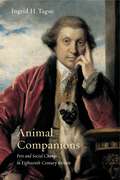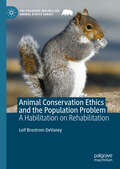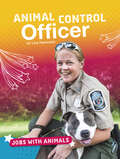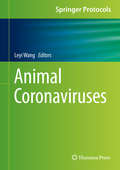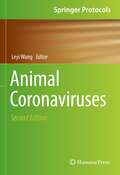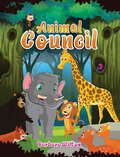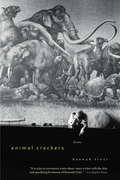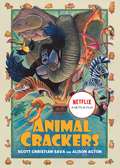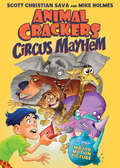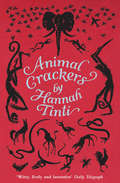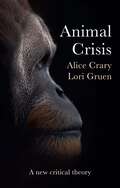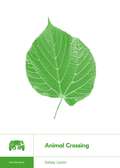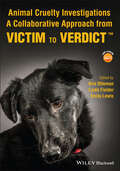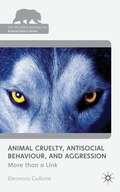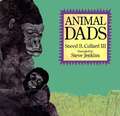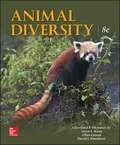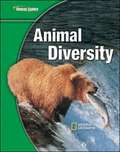- Table View
- List View
Animal Communication Theory
by Ulrich E. StegmannThe explanation of animal communication by means of concepts like information, meaning and reference is one of the central foundational issues in animal behaviour studies. This book explores these issues, revolving around questions such as: • What is the nature of information? • What theoretical roles does information play in animal communication studies? • Is it justified to employ these concepts in order to explain animal communication? • What is the relation between animal signals and human language? The book approaches the topic from a variety of disciplinary perspectives, including ethology, animal cognition, theoretical biology and evolutionary biology, as well as philosophy of biology and mind. A comprehensive introduction familiarises non-specialists with the field and leads on to chapters ranging from philosophical and theoretical analyses to case studies involving primates, birds and insects. The resulting survey of new and established concepts and methodologies will guide future empirical and theoretical research.
Animal Communication and Noise (Animal Signals and Communication #2)
by Henrik BrummThe study of animal communication has led to significant progress in our general understanding of motor and sensory systems, evolution, and speciation. However, one often neglected aspect is that signal exchange in every modality is constrained by noise, be it in the transmission channel or in the nervous system. This book analyses whether and how animals can cope with such constraints, and explores the implications that noise has for our understanding of animal communication. It is written by leading biologists working on different taxa including insects, fish, amphibians, lizards, birds, and mammals. In addition to this broad taxonomic approach, the chapters also cover a wide array of research disciplines: from the mechanisms of signal production and perception, to the behavioural ecology of signalling, the evolution of animal communication, and conservation issues. This volume promotes the integration of the knowledge gained by the diverse approaches to the study of animal communication and, at the same time, highlights particularly interesting fields of current and future research.
Animal Companions: Pets and Social Change in Eighteenth-Century Britain (Animalibus)
by Ingrid H. TagueAnimal Companions explores how eighteenth-century British society perceived pets and the ways in which conversation about them reflected and shaped broader cultural debates.While Europeans kept pets long before the eighteenth century, many believed that doing so was at best frivolous and at worst downright dangerous. Ingrid Tague argues that for Britons of the eighteenth century, pets offered a unique way to articulate what it meant to be human and what society ought to look like. With the dawn of the Enlightenment and the end of the Malthusian cycle of dearth and famine that marked previous eras, England became the wealthiest nation in Europe, with a new understanding of religion, science, and non-European cultures and unprecedented access to consumer goods of all kinds. These transformations generated excitement and anxiety that were reflected in debates over the rights and wrongs of human-animal relationships.Drawing on a broad array of sources, including natural histories, periodicals, visual and material culture, and the testimony of pet owners themselves, Animal Companions shows how pets became both increasingly visible indicators of spreading prosperity and catalysts for debates about the morality of the radically different society emerging in eighteenth-century Britain.
Animal Companions: Pets and Social Change in Eighteenth-Century Britain (Animalibus: Of Animals and Cultures #6)
by Ingrid H. TagueAnimal Companions explores how eighteenth-century British society perceived pets and the ways in which conversation about them reflected and shaped broader cultural debates. While Europeans kept pets long before the eighteenth century, many believed that doing so was at best frivolous and at worst downright dangerous. Ingrid Tague argues that for Britons of the eighteenth century, pets offered a unique way to articulate what it meant to be human and what society ought to look like. With the dawn of the Enlightenment and the end of the Malthusian cycle of dearth and famine that marked previous eras, England became the wealthiest nation in Europe, with a new understanding of religion, science, and non-European cultures and unprecedented access to consumer goods of all kinds. These transformations generated excitement and anxiety that were reflected in debates over the rights and wrongs of human-animal relationships.Drawing on a broad array of sources, including natural histories, periodicals, visual and material culture, and the testimony of pet owners themselves, Animal Companions shows how pets became both increasingly visible indicators of spreading prosperity and catalysts for debates about the morality of the radically different society emerging in eighteenth-century Britain.
Animal Conservation Ethics and the Population Problem: A Habilitation on Rehabilitation (The Palgrave Macmillan Animal Ethics Series)
by Leif Brostrom DeVaneyIn this book, Leif DeVaney brings the traditional philosophical branches of metaphysics and ethics to bear on conservation biology. While many previous attempts at asking and answering ethical questions related to conservation and other environmentally relevant activities exist, few such attempts have engaged adequately with the &“rock bottom&” approach of metaphysics. Through this metaphysically realistic lens, the ontologicalstatus of the population (as well as other ecological &“wholes&”) is challenged. DeVaney argues that individual nonhuman animals are found to have interests that parallel human interests. These include the biotic goals of survival and reproduction, as well as freedom from undue pain and suffering. From an ethical standpoint, the conclusion differs drastically from the dominant consequentialist contention that the good of some can be sacrificed for the supposed greater good of the many. DeVaney initiates the establishment of the subdiscipline of conservation metaphysics, which naturally leads to a theoretically grounded ethic.
Animal Contests
by Ian C.W. Hardy Mark BriffaContests are an important aspect of the lives of diverse animals, from sea anemones competing for space on a rocky shore to fallow deer stags contending for access to females. Why do animals fight? What determines when fights stop and which contestant wins? Addressing fundamental questions on contest behaviour, this volume presents theoretical and empirical perspectives across a range of species. The historical development of contest research, the evolutionary theory of both dyadic and multiparty contests, and approaches to experimental design and data analysis are discussed in the first chapters. This is followed by reviews of research in key animal taxa, from the use of aerial displays and assessment rules in butterflies and the developmental biology of weapons in beetles, through to interstate warfare in humans. The final chapter considers future directions and applications of contest research, making this a comprehensive resource for both graduate students and researchers in the field.
Animal Control Officer (Jobs With Animals Ser.)
by Lisa HarkraderDo you love animals? Do you enjoy making sure animals and people are safe? Read this book to learn about becoming an animal control officer.
Animal Coronaviruses (Springer Protocols Handbooks)
by Leyi WangThis detailed volume provides diagnosticians and researchers with practical methodologies and approaches to tackle animal coronaviruses. It explores conventional immunohistochemistry, virus neutralization, enzyme-linked immunosorbent assays, expression and purification of recombinant viral proteins, and various molecular assays, including conventional and real-time reverse transcription-PCR, reverse genetics methodology, and next generation sequencing and sequence analyses. As part of the Springer Protocols Handbooks series, chapters contain readily reproducible laboratory protocols as well as expert tips on troubleshooting and avoiding known pitfalls. Practical and authoritative, Animal Coronaviruses serves as an ideal reference for researchers examining a wide variety of coronavirus species in the Coronaviridae.
Animal Coronaviruses (Springer Protocols Handbooks)
by Leyi WangThis detailed new edition compiles fully updated practical methodologies and approaches for diagnosticians and researchers working toward a better understanding of animal coronaviruses. The book explores vital techniques in virus isolation, diagnostic approaches via the detection of viral nucleic acids or proteins, serology, disease-targeted animal species models, and next-generation sequencing and bioinformatics. Written for the invaluable Springer Protocols Handbooks series, chapters contain readily reproducible laboratory protocols as well as expert tips on troubleshooting and avoiding known pitfalls. Thorough and hands-on, Animal Coronaviruses, Second Edition will help readers design and carry out their increasingly important projects in clinical research, diagnostics, disease surveillance, and epidemiological study involving this family of viruses.
Animal Council
by Barbara WiltonImagine yourself in the forest wilds. If you saw some animals grouped together, what would you wonder? What are they talking about? Do they plan and discuss things just like people? There must be issues that confront animals that people don’t even think about. Just like people, every animal has a talent to contribute to the group. Which ones are the most valuable because they get the best results? Is it the big, powerful ones like the elephant and the lion, or the less noticed, unexpected ones? Take yourself on a journey to the forest and discover what really goes on.
Animal Crackers
by Hannah TintiA zoo worker, cautiously washing down Marysue the elephant, considers the strange, grim fragments he's heard of his co-workers' lives. Giraffes demand better living conditions and stage a mock group suicide. A girl escapes her repressive finishing school to find freedom with the monkeys in the African jungle. Snake or dog, buffalo, cat or turkey, each animal in Hannah Tinti's brilliant, darkly comic collection holds up a disturbing mirror to the human beings around it.
Animal Crackers (Animal Crackers)
by Scott Christian SavaIt was supposed to an exciting, yet normal trip to the circus.Dangerous stunts, flying acrobats, and even the clowns Uncle Doug hated so much—Owen is itching to see all of it. But when his little sister Zoe, a self-proclaimed animal whisperer, accuses the ringmaster of mistreating the circus animals, the last thing Owen has time to do is to watch the show! With the help of some magical animal crackers that can transform him into a bear, a hippo, or even a hamster, Owen sets out to rescue his kidnapped uncle and sister from the hands of the scheming ringmaster and his circus lackeys.
Animal Crackers: Circus Mayhem (Animal Crackers)
by Scott Christian SavaHow does Uncle Bob do it? Owen couldn't figure it out.Buffalo Bob's Rootin' Tootin' Animal Circus is famous for its jump-roping giraffe, tangoing lion, and knife-throwing elephant. But they have to be fakes, right? Owen is determined to get to the bottom of this mystery. When he visits the circus he discovers that his uncle and, coincidentally, all of the animals, are missing. It can only be the work of Buffalo Bob’s sideshow rival: Contorto.Owen stumbles upon the one thing that can save the day: Buffalo Bob’s box of animal crackers. But these aren’t any ordinary cookies: one bite and you’re transformed into a circus animal! The audience is wowed by Owen’s animal antics, but it will take more than a few carnival tricks to defeat Contorto and his pack of goons.
Animal Crackers: Stories
by Hannah TintiWith bravura storytelling, daring imagination, and fierce narrative control, this dazzling debut introduces that rare writer who finds humanity in our most unconventional behavior, and the humor beneath our darkest impulses.In these ten strange, funny, and unnerving stories, animals become the litmus test of our deepest fears and longings. In the title story, an elephant keeper courts danger from his gentle charge; in "Miss Waldron's Red Colobus," a headstrong young woman in Africa is lured by the freedom of the monkeys in the trees; in "Talk Turkey," a boy has secret conversations with the turkeys on his friend's family's farm; in "Slim's Last Ride," a child plays chilling games with his pet rabbit; in "Gallus Gallus," a pompous husband projects his anger at his wife onto her prized rooster.This fresh, inventive debut will introduce Hannah Tinti as one of the most gifted writers of her generation. Enter her world at your own risk, and you will come away bewitched.From the Hardcover edition.
Animal Crackers: Stories
by Hannah TintiWith bravura storytelling, daring imagination, and fierce narrative control, this dazzling debut introduces that rare writer who finds humanity in our most unconventional behavior, and the humor beneath our darkest impulses.In these ten strange, funny, and unnerving stories, animals become the litmus test of our deepest fears and longings. In the title story, an elephant keeper courts danger from his gentle charge; in “Miss Waldron’s Red Colobus,” a headstrong young woman in Africa is lured by the freedom of the monkeys in the trees; in “Talk Turkey,” a boy has secret conversations with the turkeys on his friend’s family’s farm; in “Slim’s Last Ride,” a child plays chilling games with his pet rabbit; in “Gallus Gallus,” a pompous husband projects his anger at his wife onto her prized rooster.This fresh, inventive debut will introduce Hannah Tinti as one of the most gifted writers of her generation. Enter her world at your own risk, and you will come away bewitched.From the Hardcover edition.
Animal Crackers: Stories
by Hannah TintiA zoo worker, cautiously washing down Marysue the elephant, considers the strange, grim fragments he's heard of his co-workers' lives. Giraffes demand better living conditions and stage a mock group suicide. A girl escapes her repressive finishing school to find freedom with the monkeys in the African jungle. Snake or dog, buffalo, cat or turkey, each animal in Hannah Tinti's brilliant, darkly comic collection holds up a disturbing mirror to the human beings around it.
Animal Crisis: A New Critical Theory
by Lori Gruen Alice CraryLeading philosophers Alice Crary and Lori Gruen offer a searing and desperately needed response to systems of thought and action that are failing animals and, ultimately, humans too. In the wake of global pandemics, mass extinctions, habitat destruction, and catastrophic climate change, they issue a clarion call to address the intertwined problems we face, arguing that we must radically reimagine our relationships with other animals. In stark contrast to traditional theories in animal ethics, which abstract from social mechanisms harmful to human beings, Animal Crisis makes the case that there can be no animal liberation without human emancipation. Borrowing from critical theories such as ecofeminism, Crary and Gruen present a critical animal theory for understanding and combating the structural forces that enable the diminishment of so many to the advantage of a few. With seven case studies of complex human-animal relations, they make an urgent plea to dismantle the “human supremacism” that is devastating animal lives and hurtling us toward ecocide.
Animal Crossing (Boss Fight Books)
by Kelsey LewinBefore the world of Animal Crossing became a pandemic lifeline for millions, the &“social sim&” communication game D??butsu no Mori, or &“Animal Forest,&” debuted in 2001 on Nintendo 64 in Japan, then once again in 2002 on GameCube to critical and commercial success all over the world. An open-ended casual game ahead of its time, Animal Crossing set the stage for the series&’s many incarnations to come with its focus on building community and friendship, its in-game currency of Bells, and its village of Animalese-speaking friends like Tom Nook, K.K. Slider, and the mean Mr. Resetti. You could visit the villages of your friends and give them gifts—all without being connected to the internet. Video game preservationist and historian Kelsey Lewin tells the story of how a mundane-sounding game full of bug-catching, letter-writing, and furniture-collecting became one of Nintendo&’s best-loved franchises, with Animal Crossing: New Horizons eclipsing Super Mario Bros. for all-time sales in Japan, unlocking gaming&’s massive potential to tap into our desire to plant trees, find friends, and make the world a better place.
Animal Crossings (Fountas & Pinnell Classroom, Guided Reading)
by Nico AtwaterNIMAC-sourced textbook
Animal Cruelty Investigations: A Collaborative Approach from Victim to Verdict
by Linda Fielder Emily Lewis Kris OttemanAnimal Cruelty Investigations: A Collaborative Approach from Victim to Verdict provides a framework for the experts who respond to animal cruelty cases: veterinarians, law enforcement agencies, animal care and control organizations, and prosecutors. This book is a practical guide which provides insight and direction for every phase of an animal cruelty investigation. The step-by-step guidance on responding to particular issues and challenges related to animal cruelty cases is bolstered by the extensive library of checklists, form templates, specific case protocols, and lists of available resources. This book is designed to empower readers to respond to animal cruelty cases confidently and effectively by: Introducing veterinarians to their critical role in animal cruelty investigations including forensic examination and necropsy, crime scene response, report writing, and testimony. Included are detailed Specific Case Protocols for common animal cruelty scenarios. Helping animal shelters navigate the challenges of holding animals in protective custody, housing unusual species, and placing evidence animals in foster care. Offering law enforcement agencies useful methods for investigating animal cruelty such as search and seizure protocols, witness interview techniques, and valuable forms and templates necessary to strengthen and ensure proper search warrant execution, evidence collection and handling, and chain of custody; all with a focus on animals as both victims and evidence. Guiding prosecutors through the steps necessary to utilize the veterinarian’s findings during trial and providing insight into issues to be considered when reviewing search warrants, filing charges, proposing plea agreements, or filing pre-conviction forfeiture motions. This book is a must-have reference and guide for veterinarians, technicians, law enforcement officers, prosecutors, and all those involved in the protection of animals’ health and wellbeing. The successful investigation of animal crimes relies on each of these disciplines, not only carrying out their professional duties, but having a collective understanding of what each other needs in order to meet that expectation.
Animal Cruelty, Antisocial Behaviour and Aggression
by Eleonora GulloneDemonstrating that animal cruelty behaviours are another form of antisocial behaviour, alongside human aggression and violence, and almost without exception are carried out by the same individuals this book offers clear recommendations for future research on animal cruelty and future action aimed at prevention.
Animal Dads
by Sneed B. Collard IIIA good book for children describing many types of animals and how their dads play a part of their lives, including the seahorse who actually gives birth to the little seahorse babies.
Animal Diversity
by Allan Larson Susan Keen Cleveland Hickman David Eisenhour Larry RobertsThis text provides a concise introduction to the field of animalbiology. Readers discover general principles of evolution, ecology, animal bodyplans, and classification and systematics. After these introductory chapters,readers delve into the biology of all groups of animals. The basic features ofeach group are discussed, along with evolutionary relationships among groupmembers. Chapter highlights include newly discovered features of animals asthey relate to ecology, conservation biology, and value to human society.Regular updates to the phylogenies within the book keep it current.
Animal Diversity
by Glencoe Mcgraw-HillDiscover the Flexibility to Teach Science Your Way!. "Glencoe Science: Animal Diversity," a module in the Glencoe Science 15 book series, provides students with accurate and comprehensive coverage of middle school National Science Education Standards. Concepts are explained in a clear, concise manner, and are integrated with a wide range of hands-on experiences, critical thinking opportunities, real-world applications, and connections to other sciences and to non-science areas of the curriculum. Co-authored by National Geographic, unparalleled graphics reinforce key concepts. A broad array of print and technology resources help differentiate and accommodate all learners. The modular approach allows you to mix and match books to meet your specific curriculum needs.

